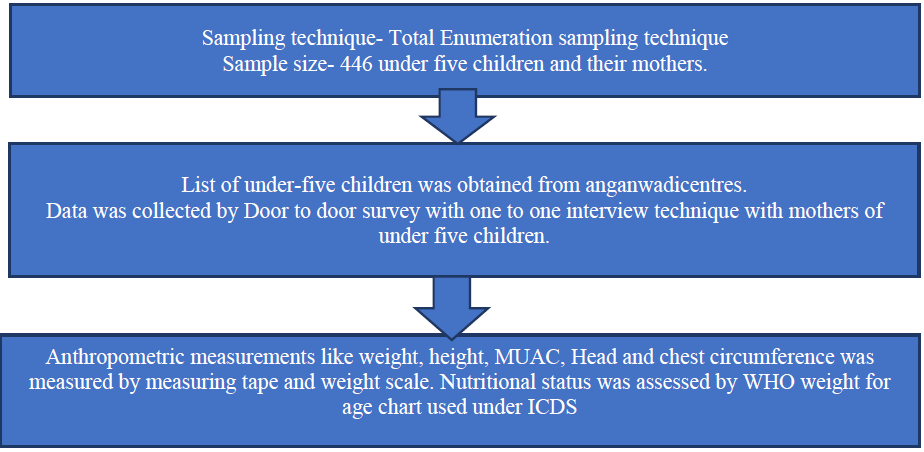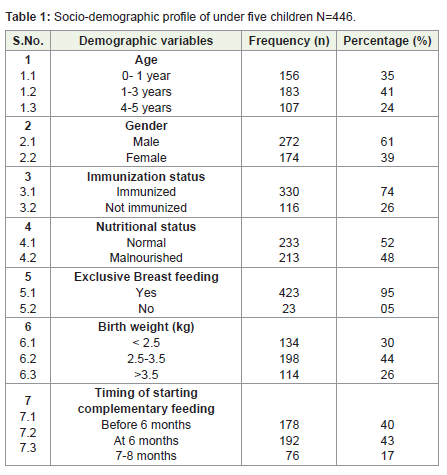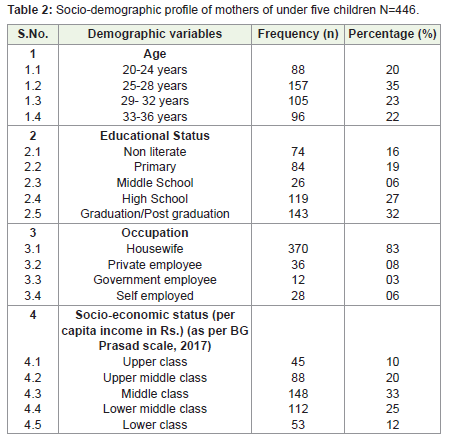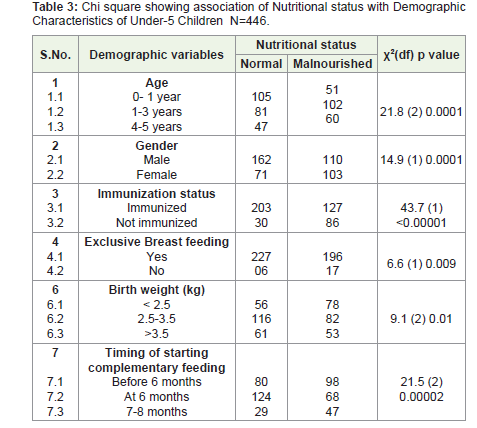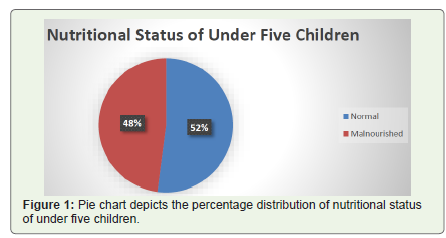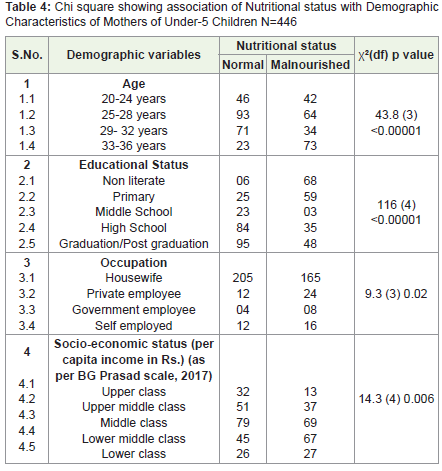Research Article
A Study to Assess the Prevalence and Determinants of Malnutrition among Under Five Children Residing in the Selected Community of Ambala District, Haryana
Pabal Preet Kaur* and Samandeep Kaur
Nursing Tutor, University College of Nursing, BFUHS Faridkot, Punjab, India
*Corresponding author: Pabal Preet Kaur, Nursing Tutor, University College of Nursing, Baba Farid University of Health Sciences, district Faridkot, Punjab, India. E-mail Id: pabalpreet@gmail.com Mobile: 7340915076
Article Information: Submission: 10/05/2023; Accepted: 06/06/2023; Published: 12/06/2023
Copyright: © 2023 Kaur PP, et al. This is an open-access article distributed under the Creative Commons Attribution License, which permits unrestricted use, distribution, and reproduction in any medium, provided the original work is properly cited.
Abstract
Background: Under- Five children are the most vulnerable group in the community. They are at a risk for getting various diseases such as Diarrhea, pneumonia, malnutrition, which may lead to childhood mortality. It was aimed to bring down the Under-five mortality to 25 per 1000 live birth under SDG
whereas; in India the mortality rate of under-five was recorded at 41.9% (NFHS-5 (2019-21)). Malnutrition is the major risk factor towards mortality and morbidity among under five-year children. It makes child more susceptible for infectious diseases by affecting the immune system. It delays the physical, intellectual, cognitive as well as psychomotor growth of a child. Hence, the present study was undertaken with the objectives to identify the malnourished children in the selected community and identify the determinants of malnutrition.
Methods: A descriptive research design was used for the present study. Subjects were comprised of children (1-5 years) and their mothers residing in Gola and Adhoya village of District Ambala. Total 446 subjects were enrolled in the study by using total enumeration sampling technique. Prior to the data
collection ethical permission was obtained from faculty of Nursing MMDU, Mullana and written informed consent was taken from mothers of under-five children. Data was collected by home to home survey from September 2020 to May 2021. Interview schedule was used to collect the Socio- demographic data of Child and mothers of under-five children. Nutritional status of children assessed through WHO weight for age chart.
Results: Results of the study shows that Less than half (41%) of children were in the age group of 1 to 3 years. Less than two-third (61%) study subjects were male and 39% were females. In the study, most of the under five children were fully immunized. More than half (52%) were having normal nutritional status whereas 48% were found to be malnourished. In the present study, the level of nutritional status was found to be highly significant (< 0.0001) with age of child, gender, immunization status, exclusive breast feeding, birth weight, timing of initiation of complementary feeding, age of mother, mothers’ educational status, occupation and socio-economic status of family, at 0.05 level of significance.
Conclusion: In the present study, prevalence of malnutrition was 48%. Factors like age, gender of the child, exclusive breast feeding, birth weight, timing of complementary feeding, economic status of the family, maternal age, education, occupation have influence on nutritional status of the child. Improvement of
maternal education will improve the nutritional status of the child. Some strategies to combat malnutrition should be made at local levels and these strategies can be used by nurses and other health professionals working in community.
Keywords: Under-five children; Health status; Malnutrition
Introduction
Under- Five children constitute the most vulnerable segment
of community. Children especially under five are prone for various
health issues such as Diarrhea, pneumonia, malnutrition, which may
ultimately lead to childhood mortality. Under the flagship of SDG,
it was aimed to bring down the Under-five mortality as low as 25
per 1000 live birth whereas, in India as per NFHS-5 (2019-21) the
mortality rate among under five was recorded at 41.9%.1 Malnutrition
is one of the major risk factor toward mortality and morbidity among
under five year children. As per the National Family Health Survey
(NFHS)-5 (2019-21), 32.1 per cent children below five years are
underweight, 35.5 per cent are stunted and 19.3 per cent are wasted
in the country [1] Malnutrition affects the child’s ability to grow
normally. It makes child more susceptible for infectious diseases by affecting the immune system. It delays the physical, intellectual, cognitive as well as psychomotor growth of a child.
Various factors such as birth weight, exclusive breast feeding,
timely initiation of complementary feeding can affect the growth and
development of a child. According to WHO breast feeding should be
initiated within half an hour in vaginal delivery and within 2 hours
in caesarean section [2]. As per IYCF guidelines complementary
feeding should be initiated after completion of 6 months along with
breast feeding [3]. Nutritional status of children remains normal till
6 months when baby is on exclusive breastfeeding. Failure in timely
initiation of complementary feeding can lead to malnutrition. Either
mother initiates the complementary feeding too early or too late.[4]
It is important to identify the under five children in community for
various health issues so, that timely intervention can used to manage
the cases. Hence, the present study was undertaken with the objectives
to identify the malnourished children in the selected community and
identify the determinants of malnutrition.
Methodology
A descriptive research design was used for the present study.
Accessible population was comprised of children (1-5 years) and
their mothers residing in Gola and Adhoya village of District Ambala.
Firstly, list of under-five children was taken from anganwadi centers.
Total 446 subjects were enrolled in the study by using total enumeration
sampling technique. Prior to the data collection ethical permission
was obtained from faculty of Nursing MMDU, Mullana and written
informed consent was taken from mothers of under-five children.
Interview schedule was used to collect the Socio- demographic data
of Child and mothers of under-five children. Assessment of the
anthropometric measurement weight, height, MUAC, chest and head
circumference were done with the help of weight scale and measuring
tape. Nutritional status of children assessed through weight for age
chart. Immunization status of child was checked with their Maternal
and Child Protection Card (MCP). Data was collected by home to
home survey from September 2020 to May 2021.
Results
[Table 1] shows the socio-demographic profile of under-five
children. Less than half (41%) of children were in the age group of 1
to 3 years whereas one third (35%) were infants. Less than two-third
(61%) study subjects were male and 39% were females. In the study,
most of the under five children were fully immunized and Near to
one fourth (26%) were not fully immunized. More than half (52%)
were having normal nutritional status whereas 48% were found to be
malnourished. Maximum subjects i.e. 95% were exclusively breastfed
for six months. In the present study, 30% of under-five were born
with birth weight of less than 2.5 kgs followed by 44 % were with 2.5
to 3.5 kgs birth weight. Complementary feeding in 40 % of children
were started before 6 months whereas only 43% of children was given
complementary diet at 6 months.
[Table 2] depicts the socio-demographic profile of mothers of
under-five children. Near to one-third (35%) of mothers were in the
age group of 25-28 years whereas near to one fourth i.e.23% were
between 29-32 years. In the present study, more than one fourth
(27%) of mothers attended high school and 16 % were non-literate.
Near to one third (32%) of mothers were graduates. Most of the
mothers (83%) of mothers were housewives. 33% of mothers were
belongs from middle class whereas only 12% were from lower class.
[Table 3] shows the chi-square association of nutritional status
of under five children with their socio-demographic profile. In the
present study, the level of nutritional status was found to be highly
significant (< 0.0001) with age of child, gender, immunization
status, exclusive breast feeding, birth weight, timing of initiation of
complementary feeding at 0.05 level of significance.
[Table 4] shows the chi-square association of nutritional status of
under five children with socio-demographic profile of mothers of
under-five. In the present study, the level of nutritional status was
found to be highly significant (< 0.0001) with age of mother, mothers’
educational status, occupation and socio-economic status of family at
0.05 level of significance.
Table 3: Chi square showing association of Nutritional status with Demographic
Characteristics of Under-5 Children N=446.
Figure 1: Pie chart depicts the percentage distribution of nutritional status
of under-five children.
Discussion
Many socio-demographic characteristics of the child and mother
are associated with the presence of malnutrition. In the present study,
Age of child, gender, birth weight, immunization status, exclusive
breast feeding and time of initiation of complementary feeding
was found to be significantly associated with nutritional status of
under-five children. The results of the present study, was found to
be consistent with a study conducted in urban and rural areas of
Maharashtra, India [5].
As per the recommendation of WHO, exclusive breastfeeding for
first 6 months of life is crucial for optimum growth, development,
and health of a child. Exclusive breastfeeding up to 6 months acts as
a protective factor against underweight among under five. It is an
important determinant for nutritional status of a child. In the present
study, duration of exclusive feeding is found to be significantly
associated with nutritional status of child.This finding was supported
by other studies [6].
It is well known that socioeconomic status is one of the important
determinants of the wellbeing of children and health. Lower the
socioeconomic status higher is the risk of under nutrition. A
supportive study done in India reveals that family with low economic
status have a significant association with under nutrition [7].
Another important factor affecting underweight was maternal
education. Mother is a universally first caregiver for the child and hence
mother’s education matters. Educated mothers are more aware of the
health services available. It was observed that low maternal education
was a risk factor for under nutrition among under five children. In
present study maternal education is significantly associated with nutritional status of child. This finding was in line with other studies.
[8-10] According to Infant and feeding practices, the idea time to
start complementary feeding is at 6 months. Early or late initiation of
complementary feeding put a child at risk of malnutrition. In current
study timing of initiation of complementary feeding is also one of the
major determinants for under nutrition among under-five children.
This result is consistent with a study conducted in Chandigarh among
under-five children [4].
Conclusion
On the basis of results of study, it was recommended that the
children having malnutrition should be identified in the community
and feeding practices should be assessed time to time for identifying
the major causes contributing to malnutrition. Community health
nurses and other health professional working in community should
educate, motivate and reinforce the mothers of under five children for
giving exclusive breast feeding, timely initiation of complementary
food. Some strategies to combat malnutrition should be made at local
levels and these strategies can be used by nurses and other health
professionals working in community.

